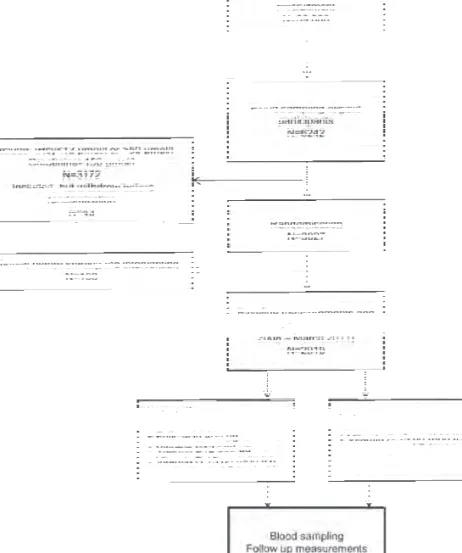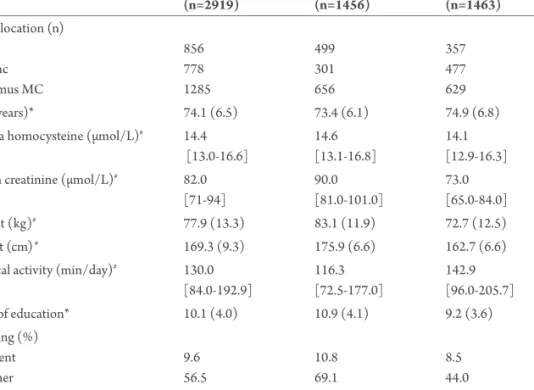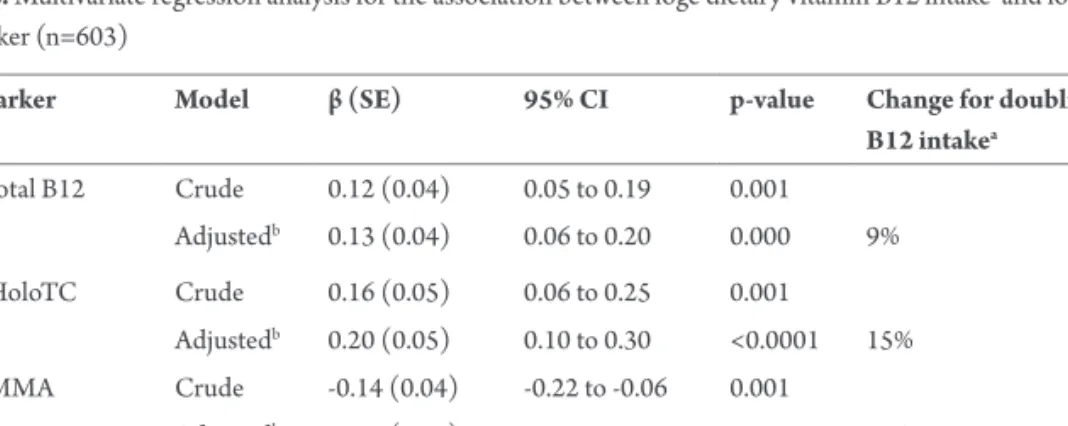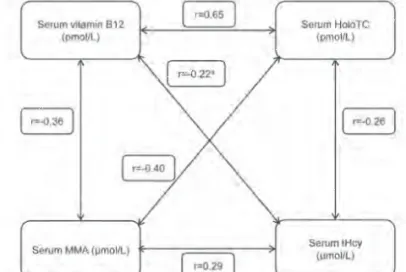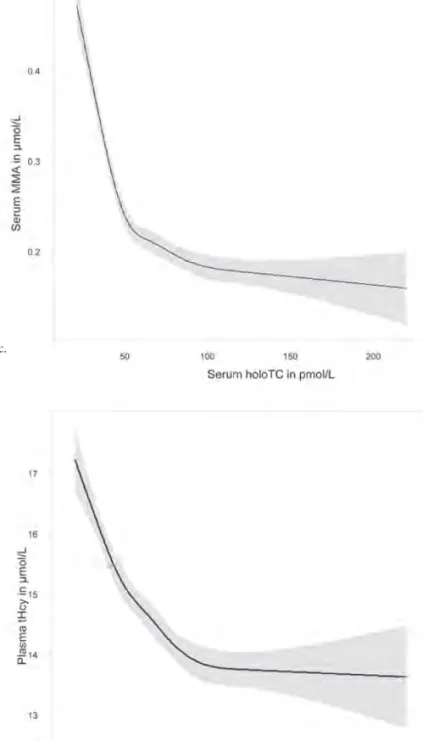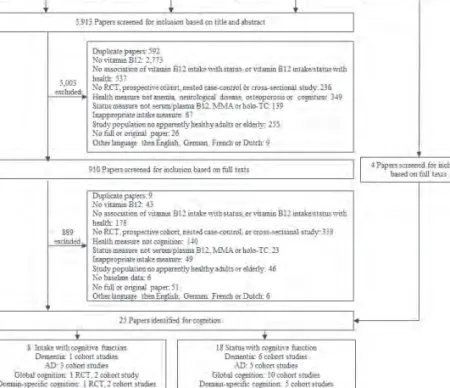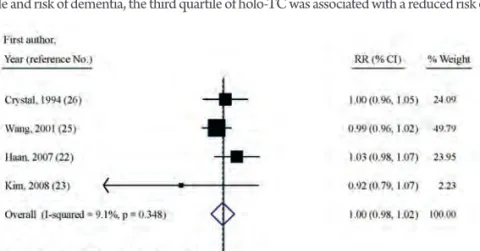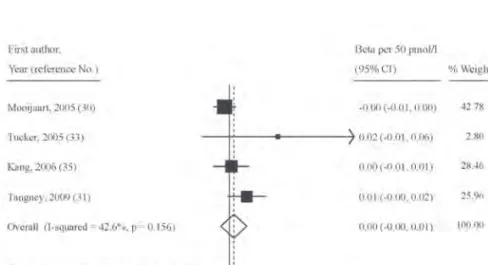The systematic review of the literature showed no or inconsistent association of vitamin B12 intake with cognitive function. At baseline, vitamin B12 and holoTC levels were not associated with cognitive function in any cognitive domain. Supplementation with vitamin B12 and folic acid did not reduce the risk of fracture in the total study population.
Vitamin B12 has been shown to stimulate osteoblast (bone-forming cell) proliferation and alkaline phosphatase activity [67], and vitamin B12 deficiency has been associated with reduced functional maturation of osteoblasts [68, 69]. Two systematic reviews with meta-analyses investigate the association between vitamin B12 intake and status with cognitive function (chapter 4), and the association between homocysteine, vitamin B12 and folate status with fracture incidence and BMD (chapter 5). In Chapter 6, we analyzed the baseline association between vitamin B12 and folate status with cognitive function in the B-PROOF study population.
Less is known about the relationship between vitamin B12 intake and levels of HoloTC and tHcy. Random effects meta-analysis showed that serum vitamin B12 (50 pmol/l) was not associated with risk of dementia (4 cohort studies), global cognition z-scores (4 cohort studies) or memory z-scores (4 cohort studies). Other studies have shown associations between baseline serum vitamin B12 and series [32] or follow-up [33] global cognition scores, associations between baseline plasma vitamin B12 and changes in cognitive decline during follow-up [34, 35], Spearman rank correlations between changes in plasma vitamin B12 and MMSE scores [ 36 ], or mean changes in MMSE scores by changes in serum vitamin B12 [ 37 ].
One RCT [45] and 2 prospective cohort studies [33, 38] addressed the association between vitamin B12 intake and domain-specific cognition. Forest plot of the association between serum/plasma vitamin B12 (50 pmol/l) and risk of dementia: Meta-Analysis of 4 prospective cohort studies (n=2630, 263 cases). Five studies reported on the association between vitamin B12 status (serum vitamin B12 n=3, holo-TC n=2) and incidence of AD.
Forest plot of association between serum/plasma vitamin B12 (50 pmol/l) and further rate of change in global cognition z-scores: Meta-analysis of 4 prospective cohort studies (n=1579). Elevated homocysteine levels and low vitamin B12 and folate levels have been associated with impaired bone health. Vitamin B12 and folate are major determinants of homocysteine metabolism [16, 17], and supplementation with vitamin B12 and folic acid has been shown to be effective in normalizing homocysteine levels [18, 19].
However, interventional studies examining the effect of vitamin B12 and/or folic acid supplementation show conflicting results [2, 3]. Treatment with vitamin B12 and folic acid, which play a central role in Hcy metabolism [17], is effective in normalizing Hcy concentrations [18, 19]. The effect of 2 years of vitamin B12 and folic acid supplementation on fracture risk was evaluated in the B-PROOF study, a randomized controlled trial (RCT).
Additionally, we assessed vitamin B12 biomarker levels as an exposure (Chapter 4, 5 and 6) and as an outcome (Chapter 3).
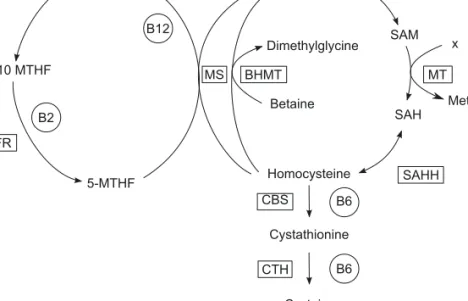
Associations between folic acid and various health outcomes were considered separately from vitamin B12, and homocysteine was not examined due to the lack of specificity for vitamin B12 deficiency [5]. Nevertheless, this review provides a comprehensive overview of the observational evidence in the association of levels of homocysteine, vitamin B12 and folate with fracture risk and BMD. This intermediate group represents a subclinical vitamin B12 deficiency, a suboptimal vitamin B12 status that occurs long before the classic clinical vitamin B12 deficiency is diagnosed.
The clinical relevance of subclinical vitamin B12 deficiency is not generally established and requires further attention to investigate the impact of this metabolic condition on the health of especially elderly people. Although many observational studies show adverse health outcomes associated with vitamin B12 levels in the subclinical deficiency range, the effect of vitamin B12 supplementation on improving health outcomes has not been established [11, 12]. The Wellness Score - which combines several markers of vitamin B12 status, as described in Chapter 6 - may be an interesting approach to evaluating vitamin B12 status, as it considers four biomarkers at the same time, which may better reflect vitamin B12 status than the level of one or two biomarkers.
Furthermore, the costs of analyzing all four biomarkers are substantial and can be avoided when agreement is reached on cutoff values for vitamin B12 deficiency. As described in Chapter 3, we observed a saturation of vitamin B12 biomarkers with a dietary vitamin B12 intake of about 5 µg, which is much higher than the current Dutch RDA of 2.8 µg/day for adults and the elderly. This may suggest that the current RDA for vitamin B12 is too low, at least for the elderly, as suggested in other studies: a cross-sectional study investigating dietary vitamin B12 intake and biomarker levels in a population of women in postmenopause [13, 14 ] and a systematic review about daily losses of vitamin B12 and bioavailability of vitamin B12 [15].
An increased need for dietary vitamin B12 may be due to the fact that many elderly people have a reduced ability to absorb vitamin B12 from food due to gastric atrophy [16, 17]. MRI measurements can provide more insight into the mechanisms by which increased homocysteine levels and low levels of vitamin B12 and folate interfere with cognitive function, as effects on specific regions in the brain can be studied which are key components to the process of cognitive decline and dementia. Several mechanisms have been proposed in literature as described in the Introduction, Chapter 4 and Chapter 6, in brief: Hypomethylation due to low vitamin B12 and folate levels and increased homocysteine levels cause myelin damage and disturbed neurotransmitter metabolism [20], homocysteine has been suggested to be neurotoxic [21], high levels of homocysteine can cause structural vascular changes in the brain [22], leading to brain atrophy and white matter hyperintensities [23, 24] and high levels of MMA can also cause neurological damage [25] .
In the B-PROOF study we observed no difference in the effect of vitamin B12 and folic acid supplementation on osteoporotic fractures and fractures of any type. The lack of an association of homocysteine, vitamin B12, and folate with BMD in the meta-analyses in Chapter 5 and in other observational studies supports the collagen cross-linking theory. High levels of homocysteine and low levels of vitamin B12 and folate were associated with increased bone resorption and decreased bone formation in several studies [28–31].
First of all, it is possible that there is no effect of vitamin B12 and folic acid supplementation on fracture risk. This finding suggests that vitamin B12 and folic acid supplementation is indeed beneficial in preventing fractures in the elderly with elevated homocysteine levels. We are still refining our analyses, and we cannot confirm or deny that vitamin B12 and folic acid supplementation had a negative effect on cancer progression in our study population.
In general, RCTs are needed to provide an evidence base for nutrient recommendations, which is still sparse in the case of homocysteine, vitamin B12 and folic acid in relation to bone health and cognitive function. We should therefore not ignore the vast body of observational research evidence regarding homocysteine, vitamin B12 and folate. Associations of homocysteine with these results and the effect of vitamin B12 and folic acid supplementation could be investigated.
In terms of cognitive function, the effect of 2-year vitamin B12 and folic acid supplementation will be studied. To conclude this thesis, our literature reviews and observational data confirm an association of homocysteine, vitamin B12 and folate levels with cognitive function and fracture risk in the elderly. Serum B12 en holoTC zijn sozvaren circulatie biomerkers, die een directe weerweg zijn van de vitamine B12 status.
Hoofdstuk 6 onderzocht de correlatie tussen de bovengenoemde vitamine B12-biomarkers en foliumzuur met cognitieve functie aan het begin van de B-PROOF studie. Hanneke van Bladel: bedankt voor het leesbaar maken van de tekst van de informatiebrochure en het deelnemersboekje. Michel Heusinkveld van de postkamer: bedankt voor het verwerken van de vrachtwagenladingen (letterlijk!) B-PROOF post.
Thanks to the Biotechnion reception staff for taking care of lost participants and passing on enormous mountains of mail. Background and design of the B-PROOF study, a randomized controlled trial of the effect of supplementary intake of vitamin B12 and folic acid on the incidence of fractures. Effect of daily vitamin B12 and folic acid supplementation on the incidence of fractures in elderly people with elevated plasma homocysteine levels: B-PROOF, a randomized controlled trial. these authors contributed equally to the content of the manuscript).
Bones, Brains and B-vitamins The impact of vitamin B12, folate and
